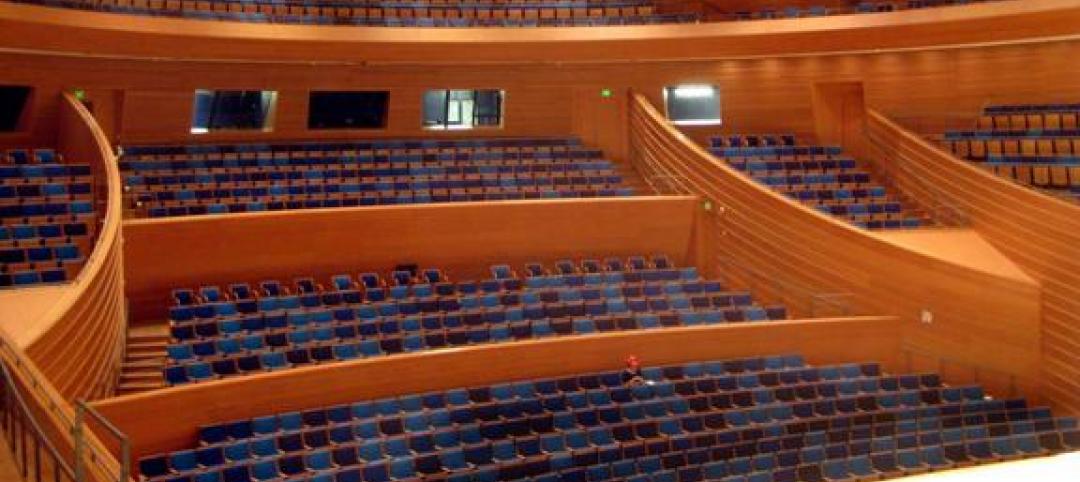The JW Marriott brand holds high standards for its luxury hotels, and the new property in Hanoi, Vietnam, is no different. The 74,384-sm building conveys a distinct Vietnamese flair, with its stylized dragon form inspired by local mythology and the country’s coastline.
Sited next to the Vietnam National Convention Center and the Hanoi Museum, convenient to nearby tourist attractions, the JW Marriott Hanoi greets visitors with a landscaped, semi-circular courtyard. Below this raised entry plaza lies a podium level housing two ballrooms; meeting facilities; dining, bar, and lounge areas; three levels of indoor parking; and back-of-house support functions. Atop the podium, the hotel includes a grand lobby, 450 guest rooms and suites, an executive lounge, a glass-enclosed rooftop swimming pool, and a fitness center.
The hotel is built for ADA compliance, even though no such laws currently exist in Vietnam. Accommodations include wider entry corridors in several rooms and special considerations in bathroom facilities. Elegant finishes are a priority throughout.
“It’s not easy working with Marriott’s standards,” remarks Building Team Awards judge Susan Heinking, AIA, NCARB, LEED AP O+M, Vice President and Director of Sustainability at VOA Associates. Indeed, this Building Team had to navigate a thicket of design requirements, including directives from owner Bitexco Group, Marriott International, and the neighboring Vietnam National Convention Center.
GOLD AWARD
Project summaryJW Marriott Hanoi Hotel
Hanoi, VietnamBUILDING TEAM
Submitting firm: Turner International – Vietnam (CM)
Owner/developer: Bitexco Group
Hotel operator: Marriott International
Architect: Carlos Zapata Studio
Architect of record: Viet Nam National Construction Consultants Corporation
Interior architects: Peter Silling & Associates Hotel Interior Design; DWP | Design Worldwide Partnership
Structural: Leslie E. Robertson Associates
Foundation: GECI
MEP: DSA Engineering Contractors: Hyundai Engineering & Construction; Delta Civil and Industrial Construction; Trung A. Stock ConstructionGENERAL INFORMATION
Project size: 74,384 sm
Construction cost: Confidential at owner’s request
Construction period: November 2009 to September 2013
Delivery method: PM/CM as agent, fast-trackMarriott’s in-house architectural group—responsible for overseeing design of all the brand’s hotels and resorts—was brought in at several stages for input and approval, but adherence to their standards proved difficult when financial problems led to a two-year delay.
Marriott criteria had changed in the interim, and new design styles caused previously selected finishes to be rejected. In addition, the clients decided to reorganize the site to make room for two villas, scrapping plans to build tennis courts and install a significant amount of landscaping.
Even basic communication was a concern, with Building Team members and consultants such as Turner Construction, Carlos Zapata Studio, Leslie E. Robertson Associates, and DSA Engineering scattered among offices in nine different countries. The firms decided early on that English would be the standard for all communications.
Vietnam is still a developing country in many aspects, so there was concern about the availability of skilled workers. Safety was also paramount, with Turner implementing weekly training sessions and audits to reinforce this priority for crews. Figuring out the best way to deploy teams—and to keep employees reporting through delays and cash-flow difficulties—made construction management even more complex.
The Building Team brought in international consultants and engineers when expertise was needed on elements unfamiliar to Vietnamese partner firms, such as the cantilevered design and structural steel construction. Sika, which supplied the waterproofing system for the podium roof, sent employees to train contractors on-site to prevent leaks that could threaten the ballrooms below.
The way the JW Marriott Hanoi came together in spite of the obstacles and difficulty level impressed the Building Team Awards judges. Says juror Matthew Dumich, AIA, of Adrian Smith + Gordon Gill Architecture: “It’s as if someone said, ‘No one knows how to do any of this stuff. Let’s do it anyway.’ And it works.”

A curtain wall system at the podium level brings natural light into the hotel’s café. Elegant finishes were a priority for the owner. PHOTO: NGUYEN HAI VAN / COURTESY TURNER VIETNAM

The structure is constructed on a podium, with ballrooms and restaurants on the lowest floor enjoying riverfront views. PHOTO: VU LONG / COURTESY TURNER VIETNAM
Related Stories
| Sep 14, 2011
Lend Lease’s role in 9/11 Memorial & Museum
Lend Lease is honored to be the general contractor for the National September 11 Memorial & Museum project at the World Trade Center site in New York City.
| Sep 14, 2011
Thornton Tomasetti’s Poon named to the Council on Tall Buildings and Urban Habitat’s Board of Trustees
During his 30-plus years of experience, Poon has been responsible for the design and construction of super high-rise structures, mixed-used buildings, hotels, airports, arenas and residential buildings worldwide.
| Sep 12, 2011
PVs play new roles as a teaching tool
Solar installations are helping K-12 schools around the country save money and teach students the intricacies of renewable energy sources.
| Sep 12, 2011
Living Buildings: Are AEC Firms up to the Challenge?
Modular Architecture > You’ve done a LEED Gold or two, maybe even a LEED Platinum. But are you and your firm ready to take on the Living Building Challenge? Think twice before you say yes.
| Sep 12, 2011
First phase of plan to revitalize Florida's Hialeah Park announced
This is the first project of a master plan developed to revive the historic racetrack.
| Sep 9, 2011
Kauffman Center for the Performing Arts in Kansas City opens this month
Theatre Projects played the lead role in theatre design and planning as well as in engineering the customized theatre equipment. BNIM in Kansas City served as the executive architect.
| Sep 9, 2011
$22 million investment made in energy efficient building maker
The buildings use at least 25% less energy than the strictest building codes in the U.S., and as much as 80% less energy in certain parts of the country.
| Sep 8, 2011
Two promoted at ajc architects
ajc architects announced the promotion of Joshua W. Greene, AIA, NCARB, LEED Green Associate to Associate Principal of the firm. The firm also announced that Kent Rigby, AIA, has been promoted to Associate Architect.
| Sep 7, 2011
KSS Architects wins AIA NJ design award
The project was one of three to win the award in the category of Architectural/Non-Residential.

















